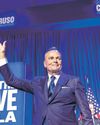CATEGORIES
Categories

Wildfires Stir Political Storm Around Mayor
LOS ANGELES—Karen Bass beat the billionaire real-estate developer Rick Caruso in Los Angeles’s 2022 mayoral race.

To Woo Trump, Zuckerberg Unleashes the 'Real Mark'
Mark Zuckerberg wants Donald Trump to get to know the \"real Mark.\"

The Rookie Who Instantly Revived the Commanders
Are we certain he's a rookie? Are we positive he's 24 years old? Has anyone gotten a peek at the paperwork? Is this really, truly his first season as an NFL professional? Because rookie NFL quarterbacks don't play football like Washington's Jayden Daniels.

Musical Fugitives
'Eat the Document' follows two 1970s radicals who go underground

Israel Defies Expectations With Surge in Tech Funding
As the war against Hamas dragged into 2024, there were worries here that investment would dry up in Israel's globally important technology sector as much of the world turned against the casualties in Gaza and recoiled at the unstable security situation.

As Democrats Try to Regroup, Fetterman Charts Own Path
Pennsylvania senator hints he is open to working with Trump, backing cabinet picks

Hunter Biden Prosecutor Rails Against President
The special counsel who prosecuted Hunter Biden delivered a stern rebuke of President Biden's claims that his son was unfairly targeted, in a report released Monday that denounced the sitting president for making what he called baseless accusations.

Middle-Class Dream Goes Up in Flames
Sylvia Sweeney and her husband, Bob Honeychurch, bought their three-bedroom home nestled in the foothills of the San Gabriel Valley for $780,000 in 2009

Gym Rats Can't Wait for You To Give Up on Your Resolution
In January, gyms become battlegrounds pitting regulars against rule-breakers

Residents’ Insurance Options Shrink
A shrinking California insurance market will leave Los Angeles-area residents more dependent on a patchwork of federal programs, charitable aid, and savings to rebuild lives devastated by the most expensive fire in U.S. history.

Los Angeles Braces for New Wind Surge
Firefighters prepare for more blazes as crews search for victims’ remains

Guard Against Space Invaders On Your iPhone
How to deal with photos and software updates that are eating up gigabytes

A Mental-Health Chatbot Becomes Children's Confidant
Part counselor, part friend, AI tool Troodi talks with kids about their worries and fears

Stars Turn Aspen Into Fashion Runway
When Hunter S. Thompson ran for sheriff of Aspen, Colo., in 1970, he vowed to rename it \"Fat City\" to prevent \"greed heads, land-rapers and other human jackals from capitalizing on the name 'Aspen.\"

Gaza Cease-Fire Deal Close, Biden Says
Talks between Israel, Hamas show progress as Trump presidency nears

The NFL Playoffs Have Delivered Quarterback Showdown for the Ages
The Bills’ Josh Allen and the Ravens’ Lamar Jackson are set to meet in the AFC divisional round

The Immigrants America Needs
Limit asylum claims, reduce welfare and open the door to highly skilled foreign nationals.

U.S. Distillers Wrestle With Bourbon Decline
When Rob Masters listed 400 barrels of two-year-old bourbon for sale online at $900 apiece, he expected them to be gone within days.

Greenland Open to New Ties
Prime minister says country will consider close defense and business links to U.S.

WELCOME TO OUR FIRST/FINAL BOOK CLUB!
Thank you, everyone, for coming to our first/final book-club meeting. Apologies for how long it's taken us to settle on a date, but in between work, kids, and the pretense of joining adult recreational sports leagues, it seems that we all have incredibly busy schedules.

ODD JOBS
\"Severance,\" on Apple TV+.

TABULA RASA
“Bleb” is worth eight points in Scrabble. Thought you might like to know. I have known the word since Wednesday, June 11, 1958, when I learned it from a company physician at Time Incorporated, in Rockefeller Center. He said I should have been hospitalized four days ago, but there was nothing much to do about it now, go back to work.

MAKE HIM LAUGH
How Lorne Michaels's sensibility governs \"Saturday Night Live.\"

ON A MISSION FROM GOD
Inside the movement to redirect billions of taxpayer dollars to private religious schools.

THE POISON MACHINE
The talk-show host Yinon Magal's hard-line tactics.

ZORA NEALE HURSTON'S CHOSEN PEOPLE
What a long-unpublished novel reveals about her magnificent obsession.

FEAR AND LOATHING
Are all our arguments really over who's harmed?

MING HAN ONG
Thadeus had never offered to take Johnny Mac out for a meal before. This is new, Johnny Mac says, grinning. For twenty-five years, Johnny Mac worked as a tenant-rights lawyer. He is a fount of varied and surprising knowledge.

Brother of Slain Leader Seeks to Rebuild Hamas
Hamas suffered a severe blow last fall when Israel killed Yahya Sinwar, the group's leader and strategist behind the Oct. 7, 2023, attacks.

As Hegseth Goes Before Senators, Ernst Looms as Key Vote
Pete Hegseth's performance will be closely watched in what is expected to be a contentious confirmation hearing on Tuesday for the defense secretary nominee. But also in the spotlight: Sen. Joni Ernst (R., Iowa), whose support the Trump transition team views as crucial.